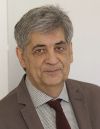Plenary Session
5EP.1
Sneak peek of the fourth plenary session
“PV in the TW Era – Scenarios for Sustainable Energy Future”

Chair, International Advisory Committee
World Conference on Photovoltaic Energy Conversion
Today we will bring you the preview of the last plenary of the WCPEC-8 on Friday, 30th September 2022. In fact, it will be the last session before the end of the conference. After a week of research papers and reports on technical challenges, this plenary session will be dedicated to the role of Photovoltaics in and for the global society. The headline of the plenary session 5EP.1 is therefore “PV in the TW Era – Scenarios for Sustainable Energy Future”.
We start with “A Critical Review of Circular Economy for Photovoltaic Modules – Status, Challenges, and Opportunities”, where Garvin Heath, NREL, Golden, United States will give key insights, gaps and opportunities for research and implementation of a circular economy solar PV. Considering that current projections foresee nearly 1.6TW deployed PV by 2050 in the United States alone, the issues of material supply, end of life management, environmental and societal impacts, and economic costs come into the focus of research. The authors screened nearly 1800 journal articles in their systematic literature review. You will have in this plenary the opportunity to save time in reading so many papers and instead get briefed directly about the current state-of-knowledge of PV in the circular economy.
Remaining in the theme on sustainability of PV with TW deployment, we will witness in plenary 5EP.1.2 the projections of Thomas Reindl, Solar Energy Research Institute of Singapore (SERIS), Singapore on the amount of areas needed for PV deployment in a 100% RE scenario. In his presentation “100% Renewable Energy scenario – What are the options to deploy all the solar panels?”, Thomas Reindl will give an overview of the global potential for different PV deployment options, considering both traditional installation forms (i.e. ground-mounted and rooftop PV) and more novel “integrated” types, especially those which enable dual use of spaces such as water bodies (Floating PV, Marine PV) and agricultural land (Agrivoltaics).
After the US and Asian view on large scale PV deployment, the next plenary 5EP.1.3 will be “Reflecting the Energy Transition from a European Perspective and in the Global Context” and reveal the “Relevance of Solar Photovoltaics Benchmarking Two Ambitious Scenarios”. Christian Breyer, University of Lappeenranta, Finland, together with his co-workers from six other institutions, analysed the share of PV in two ambitious 100% renewable energy scenarios for Europe, by 2040 and 2050. They assumed for the first time a fully sector coupled energy system transition for entire Europe leading to zero CO2 emissions by 2040, and this without shrinking final energy demand! Clearly this would need shifting more sectors to electricity, but at the present European debate on import-dependency, this plenary will hopefully show how to arrive quite soon at a domestic, CO2 neutral energy supply for whole Europe!
With plenary 5EP.1.4 we come almost to an end of the conference. A large consortium with 13 members reports on a European project “SocialRES: Social Innovations as the Pathway Towards Energy Democracy and as Sustainable Solution for the Mitigation of the Global Warming”. Silvia Caneva, WIP Renewables, Munich, Germany explains that social innovations with strong civic participation is required to make sure that the global warming will be contained within reasonable limits. The authors define such social innovations as new ideas that are not only good for the society but also enhance society’s “capacity to act”. With the concept “power to many” PV is a good showcase for such social innovation, but the plenary presentation will surely expand also on wind, wood, biogas, (shared) electric vehicles and similar new technology innovation. They also developed a toolkit to describe indicators for social innovation, such as Job creation, political mobilisation, participant income on top of the more obvious ones like avoided greenhouse gas emissions and energy savings.
As very last plenary presentation which leads us in the closing ceremony, we invited a personality giving us an outlook on the bright future of global PV, and the challenges still ahead. We are imagining a real applause for the plenary presentation, which we missed for so long.
We do hope that our plenary previews make you eager to come to Milan, and there is so much more to listen to and see. And indeed, we will be really looking forward to greet every one of you in person.